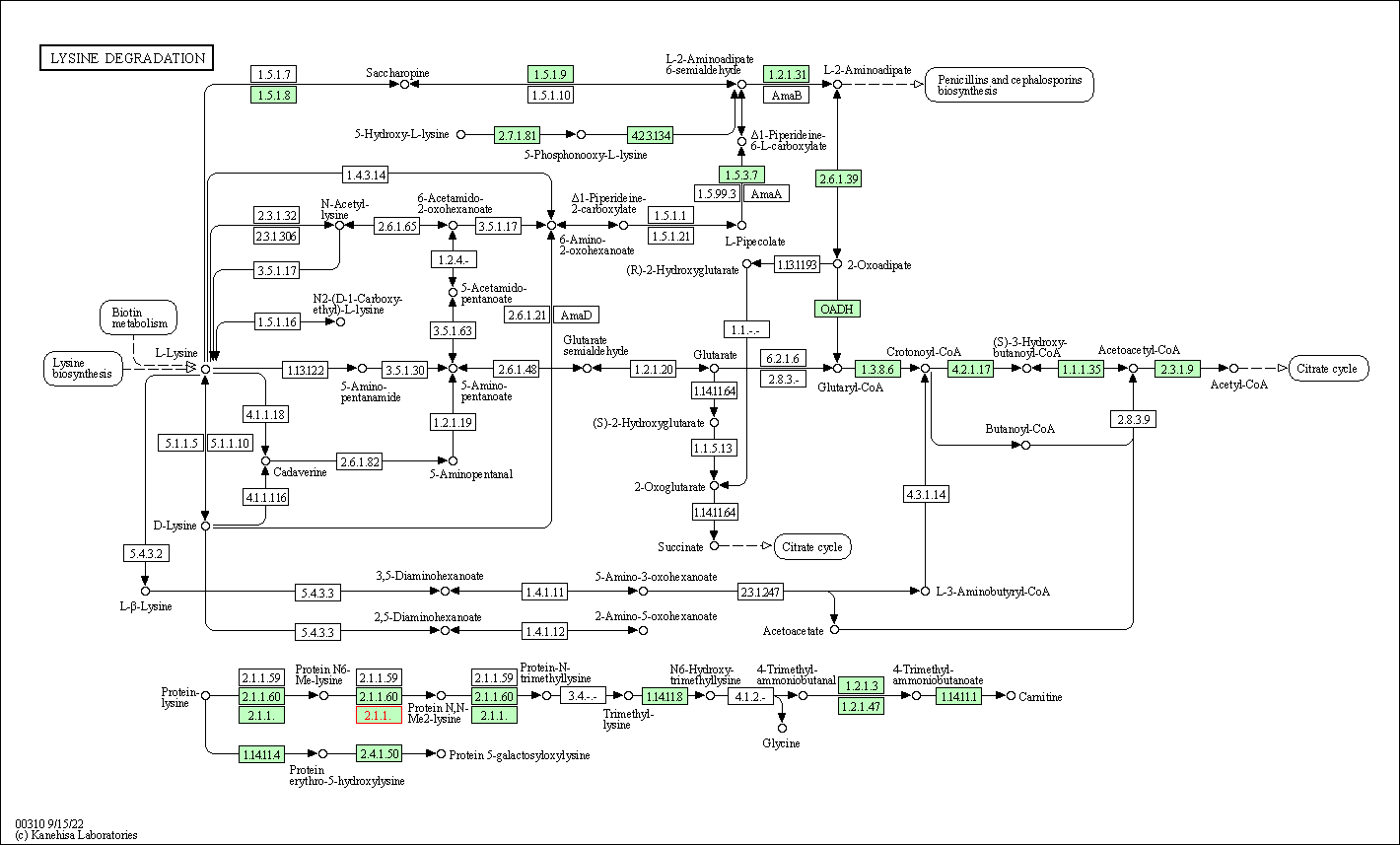Target Information
| Target General Information | Top | |||||
|---|---|---|---|---|---|---|
| Target ID |
T68490
|
|||||
| Target Name |
Histone-lysine N-methyltransferase KMT5C (KMT5C)
|
|||||
| Synonyms |
Lysine N-methyltransferase 5C; Lysine-specific methyltransferase 5C; Suppressor of variegation 4-20 homolog 2; Su(var)4-20 homolog 2; Suv4-20h2; [histone H4]-N-methyl-L-lysine20 N-methyltransferase KMT5B; [histone H4]-lysine20 N-methyltransferase KMT5B
Click to Show/Hide
|
|||||
| Gene Name |
KMT5C
|
|||||
| Target Type |
Preclinical target
|
[1] | ||||
| Function |
Histone methyltransferase that specifically methylates monomethylated 'Lys-20' (H4K20me1) and dimethylated 'Lys-20' (H4K20me2) of histone H4 to produce respectively dimethylated 'Lys-20' (H4K20me2) and trimethylated 'Lys-20' (H4K20me3) and thus regulates transcription and maintenance of genome integrity. In vitro also methylates unmodified 'Lys-20' (H4K20me0) of histone H4 and nucleosomes. H4 'Lys-20' trimethylation represents a specific tag for epigenetic transcriptional repression. Mainly functions in pericentric heterochromatin regions, thereby playing a central role in the establishment of constitutive heterochromatin in these regions. KMT5C is targeted to histone H3 via its interaction with RB1 family proteins (RB1, RBL1 and RBL2) (By similarity). Facilitates TP53BP1 foci formation upon DNA damage and proficient non-homologous end-joining (NHEJ)-directed DNA repair by catalyzing the di- and trimethylation of 'Lys-20' of histone H4. May play a role in class switch reconbination by catalyzing the di- and trimethylation of 'Lys-20' of histone H4 (By similarity).
Click to Show/Hide
|
|||||
| UniProt ID | ||||||
| EC Number |
EC 2.1.1.361
|
|||||
| Sequence |
MGPDRVTARELCENDDLATSLVLDPYLGFRTHKMNVSPVPPLRRQQHLRSALETFLRQRD
LEAAYRALTLGGWTARYFQSRGPRQEAALKTHVYRYLRAFLPESGFTILPCTRYSMETNG AKIVSTRAWKKNEKLELLVGCIAELREADEGLLRAGENDFSIMYSTRKRSAQLWLGPAAF INHDCKPNCKFVPADGNAACVKVLRDIEPGDEVTCFYGEGFFGEKNEHCECHTCERKGEG AFRTRPREPALPPRPLDKYQLRETKRRLQQGLDSGSRQGLLGPRACVHPSPLRRDPFCAA CQPLRLPACSARPDTSPLWLQWLPQPQPRVRPRKRRRPRPRRAPVLSTHHAARVSLHRWG GCGPHCRLRGEALVALGQPPHARWAPQQDWHWARRYGLPYVVRVDLRRLAPAPPATPAPA GTPGPILIPKQALAFAPFSPPKRLRLVVSHGSIDLDVGGEEL Click to Show/Hide
|
|||||
| 3D Structure | Click to Show 3D Structure of This Target | AlphaFold | ||||
| Drugs and Modes of Action | Top | |||||
|---|---|---|---|---|---|---|
| Preclinical Drug(s) | [+] 1 Preclinical Drugs | + | ||||
| 1 | A-196 | Drug Info | Preclinical | Discovery agent | [2] | |
| Mode of Action | [+] 1 Modes of Action | + | ||||
| Inhibitor | [+] 1 Inhibitor drugs | + | ||||
| 1 | A-196 | Drug Info | [1] | |||
| Cell-based Target Expression Variations | Top | |||||
|---|---|---|---|---|---|---|
| Cell-based Target Expression Variations | ||||||
| Drug Binding Sites of Target | Top | |||||
|---|---|---|---|---|---|---|
| Ligand Name: Ademetionine | Ligand Info | |||||
| Structure Description | Crystal structure of suppressor of variegation 4-20 homolog 2 | PDB:3RQ4 | ||||
| Method | X-ray diffraction | Resolution | 1.80 Å | Mutation | No | [3] |
| PDB Sequence |
DRVTARELCE
13 NDDLATSLVL23 DPYLGFRTHK33 MNVSPVPPLR43 RQQHLRSALE53 TFLRQRDLEA 63 AYRALTLGGW73 TARYFQSRGP83 RQEAALKTHV93 YRYLRAFLPE103 SGFTILPCTR 113 YSMETNGAKI123 VSTRAWKKNE133 KLELLVGCIA143 ELREADEGLL153 RAGENDFSIM 163 YSTRKRSAQL173 WLGPAAFINH183 DCKPNCKFVP193 ADGNAACVKV203 LRDIEPGDEV 213 TCFYGEGFFG223 EKNEHCECHT233 CERKGEGAFR243
|
|||||
|
|
HIS32
2.594
TYR114
3.311
MET116
3.626
GLU117
2.753
ASN119
4.394
GLY120
3.473
ALA121
2.893
PHE160
3.130
SER161
3.884
ALA179
3.290
PHE180
3.695
|
|||||
| Click to View More Binding Site Information of This Target with Different Ligands | ||||||
| Different Human System Profiles of Target | Top |
|---|---|
|
Human Similarity Proteins
of target is determined by comparing the sequence similarity of all human proteins with the target based on BLAST. The similarity proteins for a target are defined as the proteins with E-value < 0.005 and outside the protein families of the target.
A target that has fewer human similarity proteins outside its family is commonly regarded to possess a greater capacity to avoid undesired interactions and thus increase the possibility of finding successful drugs
(Brief Bioinform, 21: 649-662, 2020).
Human Pathway Affiliation
of target is determined by the life-essential pathways provided on KEGG database. The target-affiliated pathways were defined based on the following two criteria (a) the pathways of the studied target should be life-essential for both healthy individuals and patients, and (b) the studied target should occupy an upstream position in the pathways and therefore had the ability to regulate biological function.
Targets involved in a fewer pathways have greater likelihood to be successfully developed, while those associated with more human pathways increase the chance of undesirable interferences with other human processes
(Pharmacol Rev, 58: 259-279, 2006).
Human Similarity Proteins
Human Pathway Affiliation
|
|
|
There is no similarity protein (E value < 0.005) for this target
|
| KEGG Pathway | Pathway ID | Affiliated Target | Pathway Map |
|---|---|---|---|
| Lysine degradation | hsa00310 | Affiliated Target |

|
| Class: Metabolism => Amino acid metabolism | Pathway Hierarchy | ||
| References | Top | |||||
|---|---|---|---|---|---|---|
| REF 1 | The SUV4-20 inhibitor A-196 verifies a role for epigenetics in genomic integrity. Nat Chem Biol. 2017 Mar;13(3):317-324. | |||||
| REF 2 | Epigenetics and beyond: targeting writers of protein lysine methylation to treat disease. Nat Rev Drug Discov. 2021 Apr;20(4):265-286. | |||||
| REF 3 | Crystal structures of the human histone H4K20 methyltransferases SUV420H1 and SUV420H2. FEBS Lett. 2013 Nov 29;587(23):3859-68. | |||||
If You Find Any Error in Data or Bug in Web Service, Please Kindly Report It to Dr. Zhou and Dr. Zhang.

